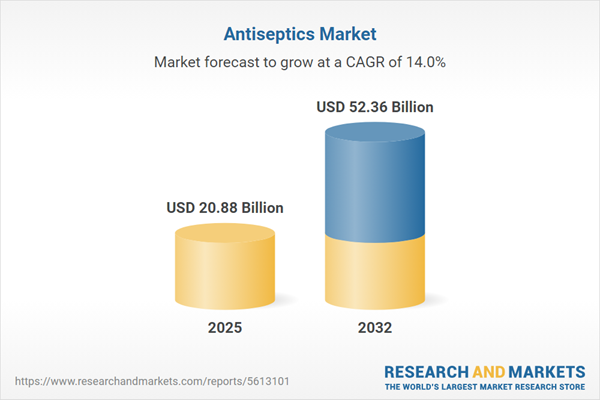Speak directly to the analyst to clarify any post sales queries you may have.
The antiseptics market is undergoing significant transformation, presenting fresh opportunities for companies that align product development with evolving healthcare standards and consumer preferences. Amid rising regulatory scrutiny and shifting global supply landscapes, industry leaders need a clear, data-driven understanding to drive competitive strategies and sustainable growth.
Antiseptics Market Snapshot
The antiseptics market expanded from USD 18.35 billion in 2024 to USD 20.88 billion in 2025 and is anticipated to achieve a robust compound annual growth rate (CAGR) of 13.99%, reaching USD 52.36 billion by 2032. This sustained acceleration is propelled by healthcare system demands, regulatory requirements, heightened infection control needs, and advances in both formulation and distribution channels. Regional variations, ongoing tariff developments, and emerging supply strategies continue to influence market momentum and risk mitigation approaches.
Scope & Segmentation
This report delivers actionable analysis across key segments, providing clarity for decision-making and resource allocation:
- Product Types: Alcohol-based (foam, gel, solution, spray), biguanides, chlorhexidine, hydrogen peroxide, iodine-based, phenolic compounds, quaternary ammonium compounds.
- Forms: Foam, gel, solution, spray, wipes.
- Applications: Disinfection of medical instruments, hand hygiene (healthcare, personal use), preoperative skin preparation, surface disinfection (healthcare, home settings), wound care.
- End Users: Ambulatory surgical centers, clinics, home care (personal use, veterinary use), hospitals.
- Distribution Channels: E-commerce (omni-channel retailers, pure-play platforms), hospital pharmacies, online pharmacies, retail pharmacies.
- Packaging Types: Aerosol cans, bottles, foil sachets, pre-saturated wipes.
- Regions: Americas (North America, Latin America), Europe, Middle East & Africa, Asia-Pacific—covering major economies and growth markets.
- Company Coverage: Analysis includes leading manufacturers such as Reckitt Benckiser Group plc, Ecolab Inc., 3M Company, Johnson & Johnson Services, Inc., STERIS plc, B. Braun Melsungen AG, Ansell Limited, Mölnlycke Health Care AB, Cardinal Health, Inc., and Paul Hartmann AG.
Key Takeaways for Senior Decision-Makers
- Stringent regulatory requirements are pushing manufacturers to invest in enhanced safety, efficacy profiling, and sustainable sourcing strategies that address emerging environmental and compliance mandates.
- Technological innovation in encapsulation, digital monitoring, and supply chain traceability is strengthening product integrity and operational efficiency across the market.
- Shifting consumer preferences are accelerating demand for natural, plant-based, and transparency-focused antiseptics, particularly in the personal and veterinary categories.
- Regional insights reveal that local regulatory harmonization and increased public-private partnerships are influencing both supply reliability and approval timelines, particularly in emerging and mature markets.
- Market leaders are leveraging cross-industry collaborations for sustainable packaging and exploring adaptive sourcing models for resilience against global trade disruptions, including recent tariff impacts.
- Strategic focus on delivery system differentiation and segment-specific messaging positions companies to address nuanced needs of healthcare professionals and eco-conscious consumers alike.
Tariff Impact: Strategic Responses to the 2025 US Tariffs
The 2025 United States tariffs introduced renewed complexity into global antiseptic supply chains, compelling manufacturers to reassess procurement and production footprints. Shifts in cost structures are driving a trend toward nearshoring and diversification of supplier portfolios, while fostering innovation in ingredient utilization and regionalized manufacturing. Strategic contracts, enhanced analytical forecasting, and closer alliances with domestic chemical suppliers have emerged as critical tactics for shielding margins and reducing vulnerability to future trade volatility.
Methodology & Data Sources
This research applies comprehensive primary interviews with infection prevention experts, R&D leaders, and procurement executives, accompanied by secondary validation through peer-reviewed journals, patent databases, and regulatory filings. Advanced scenario-based and qualitative analyses assure the depth and objectivity of the findings across all covered regions and segments.
Why This Report Matters
- Identify and anticipate regulatory, technological, and consumer trends that drive executive decisions in the antiseptics market.
- Benchmark operational models, segmentation strategies, and partnership approaches used by market leaders and emerging innovators.
- Strengthen risk management and supply chain planning in the context of shifting trade and tariff landscapes.
Conclusion
Senior leaders who act on integrated market intelligence and evolving best practices can advance resilience and growth, aligning operational and product strategies with new regulatory and customer-driven imperatives. This report equips decision-makers with the clarity needed to lead confidently in the changing antiseptics landscape.
Additional Product Information:
- Purchase of this report includes 1 year online access with quarterly updates.
- This report can be updated on request. Please contact our Customer Experience team using the Ask a Question widget on our website.
Table of Contents
3. Executive Summary
4. Market Overview
7. Cumulative Impact of Artificial Intelligence 2025
List of Figures
Companies Mentioned
The key companies profiled in this Antiseptics market report include:- Reckitt Benckiser Group plc
- Ecolab Inc.
- 3M Company
- Johnson & Johnson Services, Inc.
- STERIS plc
- B. Braun Melsungen AG
- Ansell Limited
- Mölnlycke Health Care AB
- Cardinal Health, Inc.
- Paul Hartmann AG
Table Information
| Report Attribute | Details |
|---|---|
| No. of Pages | 187 |
| Published | October 2025 |
| Forecast Period | 2025 - 2032 |
| Estimated Market Value ( USD | $ 20.88 Billion |
| Forecasted Market Value ( USD | $ 52.36 Billion |
| Compound Annual Growth Rate | 13.9% |
| Regions Covered | Global |
| No. of Companies Mentioned | 11 |









